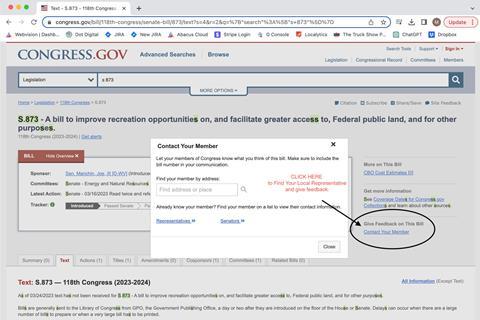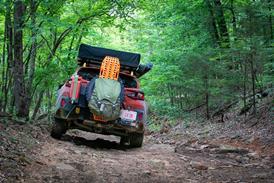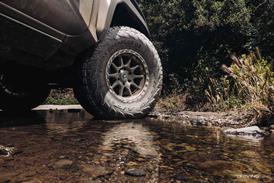SEMA, along with the Outdoor Recreation Roundtable, emphasizes the need for swift approval of the America’s Outdoor Recreation Act of 2023 (AORA), S. 873 to enable more Americans to enjoy outdoor spaces and their associated health benefits.
Senators Joe Manchin (D-WV) and John Barrasso (R-WY) have reintroduced the America’s Outdoor Recreation Act of 2023 (AORA), S. 873, in the 118th Congress. Supported by SEMA, this bipartisan legislation aims to enhance America’s outdoor recreation economy while providing sustainable economic benefits to rural communities.

The AORA is the first comprehensive recreation package since 1963, and it requires federal land management agencies to expand motorized and non-motorized access to public lands. Additionally, the bill includes provisions to streamline the process and reduce costs associated with obtaining special recreation permits. The U.S. Bureau of Land Management and the U.S. Forest Service are also required to update maps depicting where vehicles are allowed and prohibited.
“SEMA thanks Senators Manchin and Barrasso for reintroducing the America’s Outdoor Recreation Act. This bipartisan bill would streamline the process and expenses associated with obtaining special recreation permits, require federal land management agencies to increase opportunities for motorized and non-motorized access on public lands, and direct the BLM and Forest Service to make maps available to the public depicting where vehicles are allowed to recreate”said Karen Bailey-Chapman, Senior Vice President of Public and Government Affairs, Specialty Equipment Market Association (SEMA).
Studies have shown that spending time outdoors improves mental and physical health. Furthermore, the outdoor recreation industry contributes $862 billion annually to the U.S. economy and employs 4.5 million Americans.
To support this bill, please give feedback to your U.S. Senators. Here is the link to the image below.

Thanks to SEMA and Outdoor Recreation Roundtable, below is America’s Outdoor Recreation Act of 2023 Section-By-Section Summary:
TITLE I—OUTDOOR RECREATION AND INFRASTRUCTURE
Subtitle A – Declaration of Policy
Section 111. Declaration of Policy. (from Outdoor Recreation Act) This section declares that it is the policy of the Federal Government to foster and encourage recreation on Federal land, consistent with relevant agencies’ multiple use missions and the laws applicable to specific areas of Federal land.
Subtitle B – Public Recreation on Federal Recreational Lands and Waters
Section 121. Biking on Long-Distance Trails. (from BOLT Act) This section directs Federal land management agencies to identify not fewer than 10 long-distance bike trails (i.e., bike trails with at least 80 miles in total length on Federal land), and 10 areas where there is an opportunity to develop or complete long-distance bike trails. For any existing trails identified, the Secretaries may publish and distribute maps, install signage, and issue promotional materials. Prior to any trail identification, the Secretaries are required to ensure that identification would not conflict with an existing use of a trail or road, including horseback riding. This section further requires the Secretaries to issue a report that lists the trails identified under this section.
Section 122. Forest Service Climbing Guidance. (from Outdoor Recreation Act) This section directs the Forest Service to issue guidance on climbing management in designated wilderness areas on National Forests. Such guidance must recognize the appropriateness of recreational climbing in such areas, including the placement and maintenance of fixed anchors, and the use of other equipment necessary for recreational climbing.
Section 123. Designated Target Shooting Ranges. (from Outdoor Recreation Act) This section requires the Forest Service and the Bureau of Land Management (BLM) to seek to ensure that each National Forest and BLM district has at least one target shooting range that is open to the public and does not require a user fee. Agencies are to cooperate with non-federal stakeholders and partners and ensure that any shooting range constructed under this section will not adversely impact any target shooting ranges operated by nonfederal entities. Agencies may coordinate with non-Federal entities and explore opportunities to leverage funding to maximize non-Federal investments in the construction, operation, and maintenance of target shooting ranges. This section allows a target shooting range located on land transferred pursuant to the Recreation and Public Purposes Act to qualify as a target shooting range under this section.
Subtitle C – Improving Recreation Infrastructure
Section 131. Broadband Internet Connectivity at Recreation Sites. (from Outdoor Recreation Act) This section directs the Forest Service and BLM to publish a list of high-priority developed Federal recreation sites that lack broadband internet and to estimate the cost to equip those sites with broadband. This section also directs agencies to partner with the Department of Commerce to foster the installation of broadband internet infrastructure at developed recreation sites.
Section 132. Extension of Seasonal Recreation Opportunities. (from Outdoor Recreation Act) This section directs the Department of the Interior (DOI) and the Forest Service to better understand visitor trends, the effect of seasonal closures of Federal land on adjacent businesses and local tax revenue, and opportunities to extend the period of time Federal land is open to the public during seasonal closures to increase associated revenues for businesses and local governments. This section directs the agencies to make efforts to minimize seasonal closures on lands where such closures prevent recreational activities that provide economic benefits.
Section 133. Gateway Communities. (from Outdoor Recreation Act/Gateway Community and Recreation Enhancement Act) This section directs DOI and the Forest Service to collaborate with State and local governments, housing authorities, trade associations, and nonprofits to identify needs and economic impacts in gateway communities. Further, this section directs the Secretary of Agriculture, in coordination with the Secretaries of the Interior and Commerce, to provide information regarding financial and technical assistance opportunities to gateway communities (adjacent to recreation destinations) to support economic opportunities through tourism.
Section 134. Parking Opportunities for Federal Recreational Lands and Waters. (new) This section directs DOI and the Forest Service to seek to increase parking opportunities for people recreating on their lands. In order to help minimize any potential increases in the deferred maintenance backlog, this section allows the agencies to enter into public-private partnerships and lease non-Federal land for parking opportunities.
Section 135. Travel Management. (from Outdoor Recreation Act) This section directs the BLM and Forest Service to have maps available to the public depicting where vehicles are allowed and where they are prohibited, as well as to update them periodically to ensure the maps do not become outdated. In carrying out this section, agencies are required to increase opportunities for motorized and non-motorized access and experiences on Federal land.
Section 136. Public-Private Partnerships to Modernize Federally-owned Campgrounds, Resorts, Cabins, and Visitor Centers on Federal Recreational Lands and Waters. (from Outdoor Recreation Act) This section directs DOI and the Forest Service to establish a pilot program for public-private partnership agreements to modernize campgrounds and buildings on Forest Service and BLM land. Agreements are not to exceed 30 years and must include certain capital expenditure and maintenance requirements. At least one agreement would be required for each region of the National Forest System and for five States in which the BLM administers land.
Section 137. Forest Service Pay-For-Performance Partnerships. (from Outdoor Recreation Act) This section establishes a pilot program to formally authorize financing partnerships on National Forest service lands for recreation projects. This section allows the agency to enter into project agreements with private sector partners that agree to pay for all or part of projects on Forest Service lands as a long-term investment, using an innovative funding model where investments are paid in full when specified recreation-related outcomes are met. Project agreements cannot be longer than 20 years or exceed $15 million.
Subtitle D – Engagement
Section 141. Identifying Opportunities for Recreation. (from Outdoor Recreation Act) Consistent with the direction provided in Federal Land Policy and Management Act (FLPMA) and the Outdoor Recreation Act of 1963, this section requires the Federal land management agencies to conduct an inventory and assessment of current recreation resources, to identify any trends relating to use, and consider future recreation needs. After identifying underutilized locations, the agencies must consider the suitability for developing, expanding, or enhancing these recreation resources. After, the agencies are to select high-value recreation resources at which to expand and encourage recreation use. To avoid duplicative efforts, the agencies may use existing work already completed or in progress for similar inventories required under FLPMA. This section does not affect land management plans, but actions undertaken pursuant this section are to be consistent with any applicable existing management plans.
Section 142. Federal Interagency Council on Outdoor Recreation (new) This section establishes a Federal Interagency Council on Outdoor Recreation (FICOR) to help coordinate the implementation of this Act across multiple Federal departments and agencies, and applicable State and local agencies and offices.
Section 143. Informing the Public of Access Closures (new) This section requires relevant land management agencies to post on their website notifications of any temporary closures of roads and trails on the respective unit.
Section 144. Improved Recreation Visitation Data. (from Outdoor Recreation Act/Gateway Community and Recreation Enhancement Act) This section directs the Forest Service and certain agencies within the DOI to establish a single visitation data system to collect, model, and report accurate annual visitation data, categorizing the data to capture estimates of different recreation activities. This section also establishes the Real-time Data Pilot Program to make available to the public real-time or predictive visitation data for Federal lands. The pilot program is only to be carried out in areas where gateway communities are supportive, and in coordination with community partners and third-party providers, such as technology and data companies.
Sec. 145. Monitoring for Improved Recreation Decisionmaking. (new) This section requires relevant land management agencies to pilot the use of new techniques to try to count visitors that participate in forms of visitation that have been historically difficult to track.
Sec. 146. Access for Servicemembers and Veterans. (from Recreation Not Red Tape Act) This section encourages the Secretaries of Agriculture and of the Interior to work with the Secretaries of Defense and Veterans Affairs to ensure servicemembers and veterans have access to outdoor recreation and outdoor-related volunteer wellness programs.
Section 147. Increasing Youth Recreation Visits to Federal Land. (new) This section requires the Department of Agriculture and DOI to develop a national strategy to increase youth recreation on Federal lands.
TITLE II—AMENDMENTS TO THE FEDERAL LANDS RECREATION ENHANCEMENT ACT
Section 201. Short title.
Section 202. Definitions. (from SOAR Act) This section amends the Federal Lands Recreation Enhancement Act (FLREA) to list out the various types of Special Recreation Permits.
Section 203. Special Recreation Permits and Fees. (from SOAR Act) This section amends FLREA to include special recreation permits and fees. Specifically, this section codifies direction to land management agencies to develop and make special recreation permit applications available to the public. Upon receipt of such applications, the agencies may issue special recreation permits to applicants (which may include an authorization for incidental sales).
This section allows land management agencies to charge a special recreation permit fee for the issuance of a special recreation permit. Specifically, this section allows the agency to charge fees one of several different ways: a predetermined fee based on visitor-use days or a flat rate, or one of two calculations based on gross receipts. In most of these cases, the permittee chooses the fee regime that will apply for their permit. This section does not affect commercial use authorizations or cost recovery.
This section relocates existing provisions of law pertaining to the disclosure of fees to this section of FLREA, including the requirement to post entrance fee requirements. Additionally, this section requires the agencies to disclose, at the point of collection, how much money is being collected annually and how the money is being spent. Finally, this section allows a recreation service provider to inform customers of any fees charged by agencies under FLREA.
Section 204. Online Collection of Certain Recreation Fees. (from Recreation Not Red Tape Act) This section amends FLREA to allow Federal land management agencies to collect online payment for entrance fees, standard and expanded amenity recreation fees, and special recreation permit fees.
Section 205. Online Purchases and Establishment of a Digital Version of America the Beautiful—The National Parks and Federal Recreational Passes. (from Recreation Not Red Tape Act) This section directs DOI and the Forest Service to sell the America the Beautiful - the National Parks and Federal Recreational Lands Pass online, in addition to in-person sale locations currently authorized under law. In addition, this section directs DOI and Forest Service to create a digital version of the pass to be used by the public.
Sec. 206. Availability of Federal, State, and Local Recreation Passes. (from Recreation Not Red Tape Act) This section allows Federal agencies, on the request of a State or country, to sell State or county entrance or recreational passes. The Secretaries may collect fees flowing from such sales, and are required to transfer any collected funds to the applicable State or county.
Section 207. Use of Special Recreation Permit Fee Revenue. (from SOAR Act) This section amends FLREA to allow fee revenues currently retained at the site of collection to be used to improve the special recreation permitting program (in addition to all current allowable expenditures).
Section 208. Permanent Authorization. (from SOAR Act) This section permanently authorizes FLREA.
TITLE III—SPECIAL RECREATION PERMITS FOR OUTFITTING AND GUIDING
Subtitle A—Administration of Special Recreation Permits for Outfitting and Guiding
Section 311. Permit Administration. (from SOAR Act) This section requires land management agencies to publish on their websites when certain additional permit opportunities are available to outfitting and guiding businesses. Further, this section directs them to provide email subscriptions for potential applicants, notifying them of permit availability. Finally, this section requires agencies to respond to an applicant within 60 days of receipt of an application for a special recreation permit.
Section 312. Forest Service and Bureau of Land Management Transitional Special Recreation Permits for Outfitting and Guiding. (from SOAR Act) This section directs relevant land management agencies to implement a program to issue special recreation permits that are for terms of two years that have the ability to be converted to 5 or 10-year terms, provided that certain requirements are met.
Section 313. Surrender of Unused Visitor-Use Days. (from SOAR Act) This section specifies that a recreation service provider may notify relevant agencies of its inability to use the days allocated to them under their permit, and to surrender those days for temporary reassignment to other outdoor recreation service providers and the unguided public.
Section 314. Reviews for Transitional Permits and Long-Term Permits. (from SOAR Act) This section requires agencies to periodically review the performance of recreation service providers with longer-term, outfitter and guide-related special recreation permits. It also requires the Forest Service and allows DOI agencies to review whether all of the days made available to recreation service providers under their permit are being used. In making the latter determination, this section allows for recreation service providers to not be penalized for not using days if conditions exist beyond their control. It incentivizes recreation service providers to make available to others any days that they were allocated but not able use.
Section 315. Adjustment of Allocated Visitor-Use Days. (from SOAR Act) This section establishes a framework that agencies may use to adjust the number of days available under longer-term permits after reviews required under Section 314 are completed. Further, this section allows agencies to assign additional visitor-use days to special recreation permits.
Subtitle B—Additional Provisions Relating to Special Recreation Permits
Section 321. Permitting Process Improvements. (from SOAR Act) To simplify the special recreation permitting process, section 321 directs agencies to evaluate the current permitting process and to identity opportunities to decrease duplicative processes, costs, and permitting times. In addition, this section directs the agencies to evaluate the wording and terms of their existing categorical exclusions to ensure consistency with this Act and to revise them as necessary.
This section prohibits agencies from conducting a needs assessment as a condition of issuing a special recreation permit, unless specifically required under the Wilderness Act. This section also requires agencies to make permit applications available online. Lastly, this section specifies when agencies are to issue special recreation permits and when they are not required because the activities to be undertaken only would have nominal effects on resources and programs.
Section 322. Service First Initiative and Multijurisdictional Trips. (from SOAR Act) This section amends the Service First Act by establishing a pilot program that authorizes agencies to issue a single joint special recreation permit for recreation activities that cross multiple agency boundaries. This section requires agencies to issue at least 10 joint special recreation permits through at least 4 different offices under the pilot, and to designate a lead agency for issuing and administering each permit under the pilot. This section requires that agencies retain their own respective authorities for permit issuance and enforcement, and does not prohibit any person or entity from applying for separate special recreation permits.
Section 323. Permit Flexibility. (from SOAR Act) This section directs agencies to establish guidelines to allow permit holders to engage in new activities that are substantially similar to those authorized in their current permits without the issuance of entirely new and separate permits.
Section 324. Liability. (from SOAR Act) This section clarifies when relevant land management agencies may require a commercial general liability insurance policy as a condition of receiving a special recreation permit, except in the case of low-risk activities conducted under the permit, as well as the required contents of such policies. This section also provides an exemption for state or local government entities from the current requirement to indemnify the United States government, in certain circumstances.
This section also allows recreation service providers to use liability release forms in states where such forms are allowed. It also directs the agencies to have consistent policies for regulating the use of waivers within 2 years of the date of enactment of this Act.
Section 325. Cost Recovery Reform. (from SOAR Act) This section clarifies that Federal land management agencies may collect and assess reasonable cost recovery fees from special recreation permit holders and applicants. This section stipulates that the agencies shall establish a de minimis threshold for cost recovery if work done for a permittee or applicant exceeds that de minimis threshold, the agencies may not back charge for hours below the threshold. This section also directs the agencies to process and charge fees on a prorated basis when work done for multiple special recreation permit applications overlaps. Finally, this section prohibits agencies from applying cost recovery for any programmatic environmental reviews.
Section 326. Permit Relief for Picnic Areas. (from Outdoor Recreation Act) This section allows outfitters to use picnic areas on Federal lands without requiring a permit, subject to size and frequency restrictions.
Section 327. Interagency Report on Special Recreation Permits for Underserved Communities (from bill to report on certain recreation opportunities in underserved communities)
This section directs the Secretary of the Interior and the Secretary of Agriculture to issue a report on special recreation permits serving rural or urban, underserved communities relative to outdoor recreation opportunities. The Secretaries are to submit the report to Congress within three years.
Subtitle C—Effect
Section 331. Effect. This section states that unless explicitly stated, nothing in the bill shall be construed as affecting the authority or responsibility of the Secretary of the Interior to award National Park Service concessions contracts or commercial use authorizations.
TITLE IV—MISCELLANEOUS PROVISIONS
Section 401. Filming and Still Photography Within the National Park System and on Other Federal Land. (from FILM Act) This section amends current law (in two places—one for the National Park Service and one for the other Federal land management agencies) to modernize film and photography permitting on public lands to account for changing technology and social media, and to ensure that permitting determinations are appropriately based on actual impacts to resources instead of distinguishing between types of filming or photography, content, or whether the filming or photography results in financial gain.
Specifically, this section allows land management agencies to require permits and associated fees on recreational lands and waters for filming and photography that involve groups of more than eight people, or that do not adhere to certain requirements related to resource impacts. Further, this section prohibits permitting and fee requirements for filming and photography that is merely incidental to an otherwise authorized or allowable activity. In addition, this section directs the agencies to establish de minimis use authorizations for filming and photography activities that involve groups of six to eight people and that adhere to certain requirements related to resource impacts. Such authorizations are to be issued immediately upon request by an applicant.
Section 402. Volunteer Enhancement Program. (from Recreation Not Red Tape Act) This section updates the Volunteers in the National Forests Act. Specifically, this section adds the BLM to the Act, renames the act the “Volunteers in the National Forests and Public Land Act”, and adds a clause describing the purpose of the act. Further, this section adds additional authorized activities and expenses under the act and clarifies when the Secretary should supervise volunteers and that volunteers are not required to carry liability insurance to provide volunteer services under the Act.
Section 403. Cape and Antler Preservation Enhancement. (from CAPE Act) This section amends existing law, which currently authorizes (under certain conditions) qualified volunteers to participate in non-native wildlife management activities on National Park System land. Upon taking a non-native animal, current law allows the Secretary to authorize the donation and distribution of meat of the animal to certain entities. This section extends the scope of current law to include any other part of the animal—including the cape, hide, horns and antlers.
Section 404. Federal Land and Aquatic Resource Activities Assistance. (from Outdoor Recreation Act) This section clarifies that relevant DOI agencies and the Forest Service may inspect and decontaminate watercraft entering and leaving Federal land and water located within a river basin that contains a Bureau of Reclamation project. This section establishes a competitive grant program within the Bureau of Reclamation to help non-Federal partners conduct inspections and decontamination of watercraft around reservoirs administered by the DOI.
In carrying out this section, DOI is to coordinate with non-Federal partners and consult the Aquatic Nuisance Species Task Force to identify potential improvements in the detection and management of invasive species on Federal land and water.
Section 405. Amendments to the Modernizing Access to our Public Land Act. (new) This section makes technical modifications to the MAP Lands Act, which was enacted into law on April 29, 2022.
Section 406. Outdoor Recreation Legacy Partnership. (from Parks, Jobs, and Equity Act/Outdoors for All Act) This section formally authorizes the DOI’s Outdoor Recreational Legacy Partnership (ORLP) program, but lowers the threshold for areas to be eligible from 50,000 people to 25,000 people and gives the National Park Service flexibilities to improve program operations.
Section 407. Recreation Budget Crosscut. (new) This section requires the Office of Management and Budget to report the total amount of funding spent by the US government related to outdoor recreation after each fiscal year.





















No comments yet